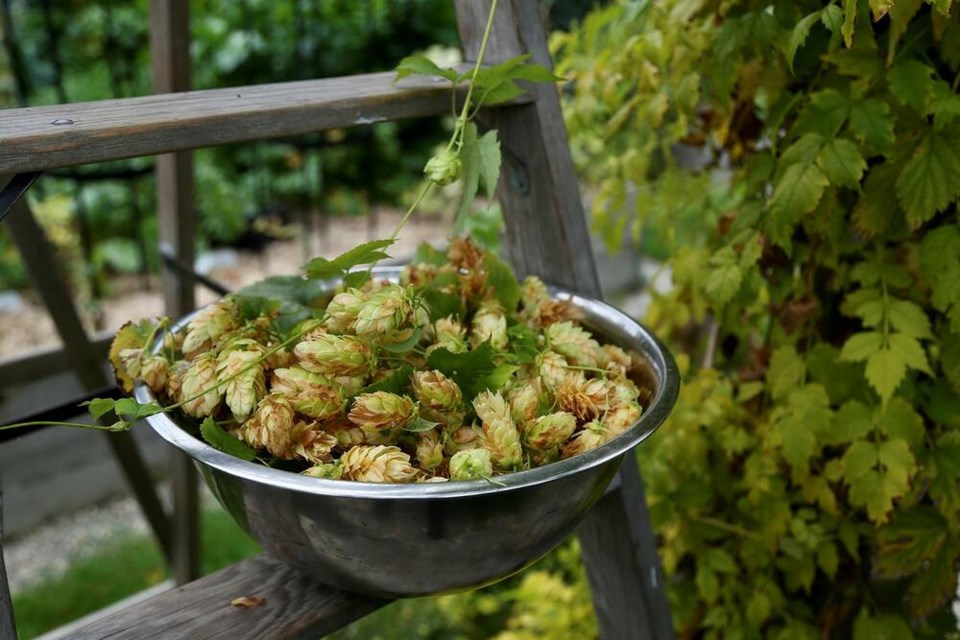Hops flowers, most often associated with beer making, have so much to offer than meets the eye. They are neither colourful nor showy, but they are elegant, strong, and uncommonly resilient. I love these ancient, medicinal and culinary blossoms. Perhaps it is my Bavarian roots that ground me in hop fandom.
A half dozen years ago or so, my son and I made small-batch beer from scratch. We didn’t know anything about brewing at the time, but we made stellar beer. Most definitely it was the hops that made it great. Pushing our luck still further, we made malt vinegar from the beer. Hands down, it was the best malt vinegar we’d tasted – sweet and savoury, punctuated by summer garden umami.
A few summers ago, when we installed a food forest trellis along the perimeter of our home garden, we interplanted Centennial and Cascade hops alongside perennial native honeysuckle, grapes and figs, as well as assorted annual food crops like sunflowers and beans and such.
We had been warned by assorted master gardeners, that hops would both “stink to high heaven” and attract rodents. I hadn’t heard anything about either eventuality from my Bavarian family, so I pressed on in good faith.
As it turns out, my olfactory receptors are purpose-built for hops, because I very much love the subtle, near invisible gossamer blooms, and the overtly flowery, sappy, resin-like fragrance that I take on faith is off-putting to some. There has been no stink, and there have been no rodents.
Typically, hops plants are string-trellis farmed as a monoculture crop, for beer, though permaculture suggests a polyculture neighborhood of simpatico species that benefit from and assist each other both above ground and below. Our polyculture food forest trellis is thriving, and we take great pleasure in harvesting the hops, to dry for beer and for tea, and for use in cooking.
During this change of seasons, when our Circadian rhythms are challenged by darkness so sudden and so early, homegrown hops tea fortified with sweet bits of cinnamon and star anise, and a leaf or two of holy basil, helps us fall asleep and stay asleep until dawn.
For thousands of years, hops have been cultivated for brewing, for medicinal use, and for food. Great institutions, and minds far greater than mine have studied the medicinal and health-enhancing benefits of hops. Research suggests that hops promote calm, restfulness, uninterrupted sleep, detoxification, effective digestion and elimination, and skin health.
Hops are rich in beneficial phytonutrients and powerful antioxidants, and also contain strong antimicrobial properties. Their taste and aroma is slightly skunky, like cannabis, which is interesting because the two plants are cousins within the Cannabaceae family. Beer and cannabis – crazy, right?
Interestingly, in spite of hops’ relative obscurity outside of the brewing industry, a hops renaissance of sorts is emerging. “Sober” hops canned teas, hops tinctures, hops kombuchas and such are headlining the high-end consumer packaged goods space. How fabulous that a lowly, “stinky”, near invisible flower could command such attention and premium price point.
I am content to grow my own hops health and wellness on a simple trellis in our yard, and then experiment in the kitchen. Hops are very easy to grow in a container, around the frame of a window or door, or under the eaves of a house. Local growers sell slips of varieties well suited to our climate, and nurseries stock hops vines in the spring.
Check with your healthcare provider before ingesting herbal medicines.
Laura Marie Neubert is a West Vancouver-based urban permaculture designer. Follow her on Instagram @upfrontandbeautiful, learn more about permaculture by visiting her Upfront & Beautiful website or email your questions to her here.
For a taste of permaculture, watch the video below:







